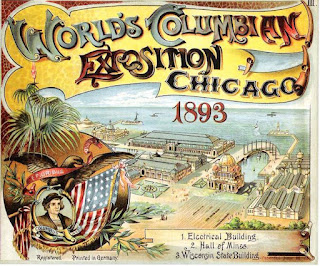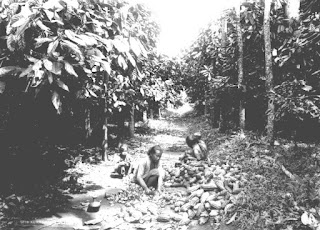CHOCOLATE FUTURES
Modernization brought in by the Industrial Revolution made chocolate accessible to the masses. Aggressive chocolate company marketing campaigns imprinted chocolate’s new consumer-friendly image, but in doing so distanced the public away from the growers. To most chocolate lovers, the cacao farmers struggling to make a precarious living and the environmental threats to cacao-producing regions are invisible. Throughout the twentieth century, lack of awareness and low demand for ethically-grown cacao played a role in maintaining unjust practices in the unseen side of the chocolate industry. Twenty-first century consumers sensible of social inequities and environmental threats seek ways to shop ethically—even in things as small and non-essential as the choice of brand for a dollar bar of chocolate. Fairtrade, a global nonprofit organization aids ethically-minded consumers with the simple, identifiable packaging mark pictured above. Purchasing chocolate with a Fairtrade certification seal partners the consumer with a global effort to democratize chocolate production and secure equitable pricing, cacao workers’ rights, and environmental protection.
Fairtrade established their certification program and standards to overcome some of the problems facing cacao producers. Certification is done by a third-party. An unrelated entity—not the producers nor the chocolate companies—confirms that everyone involved complies with agreed-upon trade terms. Fairtrade producer organizations pay an annual certification fee to cover costs. With the seal, producers and sellers give their guarantee that their cacao is environment-friendly and gives benefit to the producers. To qualify as Fairtrade producers, smallholders have to be democratically organized—in practice, members of a cooperative—and meet minimal social, economic, and environmental standards. Through the cooperatives, Fairtrade protects against trade injustice by reinforcing a notion of accountability.
To create stability, Fairtrade standards guarantee farmers a sustainable price for their products and a premium for reinvestment. Companies that buy from farms belonging to a Fairtrade certified group pay world market price or the Fairtrade minimum standard—whichever is higher—protecting producers from market volatility. The minimum price ensures farmers a consistent living income and workers a living wage. Financial stability frees farmers to plan for the future. The Fairtrade Premium, a stipend over and above the cacao price, gives producer cooperatives monies to go to a “communal fund.” Farmers have a say in how the fund is spent. Premium monies may be divided into direct payments to growers, but most of the time co-op governing boards use the Premium to benefit the community. Community projects run from water, schools, and health units, to individual equipment, training, loans, or organic certification to raise the commercial value of a cacao crop.
All Fairtrade producer members are required to adhere to International Labor Organization guidelines for hired workers. ILO conventions include freedom from discrimination and forced labor. As a result of Fairtrade’s requirement for gender equality standards, for example, the female Fairtrade cacao farmers on the Ivory Coast who don’t own their land are able to invest in their farms. Investment raises productivity and quality, and their increased income leads to improvement of their children’s lives. Forced, or “unfree” labor on cacao farms include laborers in dire poverty who lack other livelihood opportunities, or children from broken families with little choice but to work. Yearly Fairtrade zero-tolerance inspections protect vulnerable workers from unethical labor practices. Regular inspections also assure that cacao producers meet child labor standards, with inspectors acting immediately to secure the children’s safety if infractions are found. By ensuring that all workers are paid fairly, Fairtrade reduces the need for families to force their children to work to help support the home. As a result, children can instead acquire a proper education.
Looking to the future of cacao production, Fairtrade standards emphasize ecologically and agriculturally sound practices. Members practice environmental sustainability in cacao production and are prohibited from using dangerous agrichemicals and GMOs. To encourage organic approaches, producers are rewarded with higher Fairtrade minimum prices for organically grown products. In addition to local efforts, Fairtrade Climate Academies and Youth Ambassadors focus on environmental issues and climate change. Because Fairtrade farmers and workers are on the frontline of the climate crisis, Fairtrade conducts studies on climate change to identify future climate extremes and the potential impact on cacao production.
Awareness and action close the distance between the tree and the treat. By purchasing Fairtrade certified chocolate, consumers vote with their pocketbook to partner in a global effort to erase inequity and democratize chocolate production. Fairtrade does have detractors including critics who complain that the certification fee is out of reach for some of the world’s poorest farmers and workers. Others note that Fairtrade’s competitive worker pay rates add to the premium price of Fairtrade certified chocolate, forfeiting budget-conscious consumers who shop only for low-cost products. Still others bemoan the implausibility of setting one-size-fits-all standards on every cacao farm or plantation. In spite of alleged flaws, consumer support of Fairtrade certified products enables cacao farmers and workers to invest in their lives and take more control of their future. Fairtrade may not be perfect, but it takes a big step in the right direction.
BIBLIOGRAPHY:
HIS429. Lecture 8. Chocolate Futures
“Key Issues.” Fairtrade. Accessed October 29, 2021. https://www.fairtrade.net/issue
Leissle, Kristy. Cocoa. Cambridge: Polity Press, 2018.
Ryan, Orla. Chocolate Nations Living and Dying for Cocoa in West Africa. London: NBN International, 2011.



Comments
Post a Comment